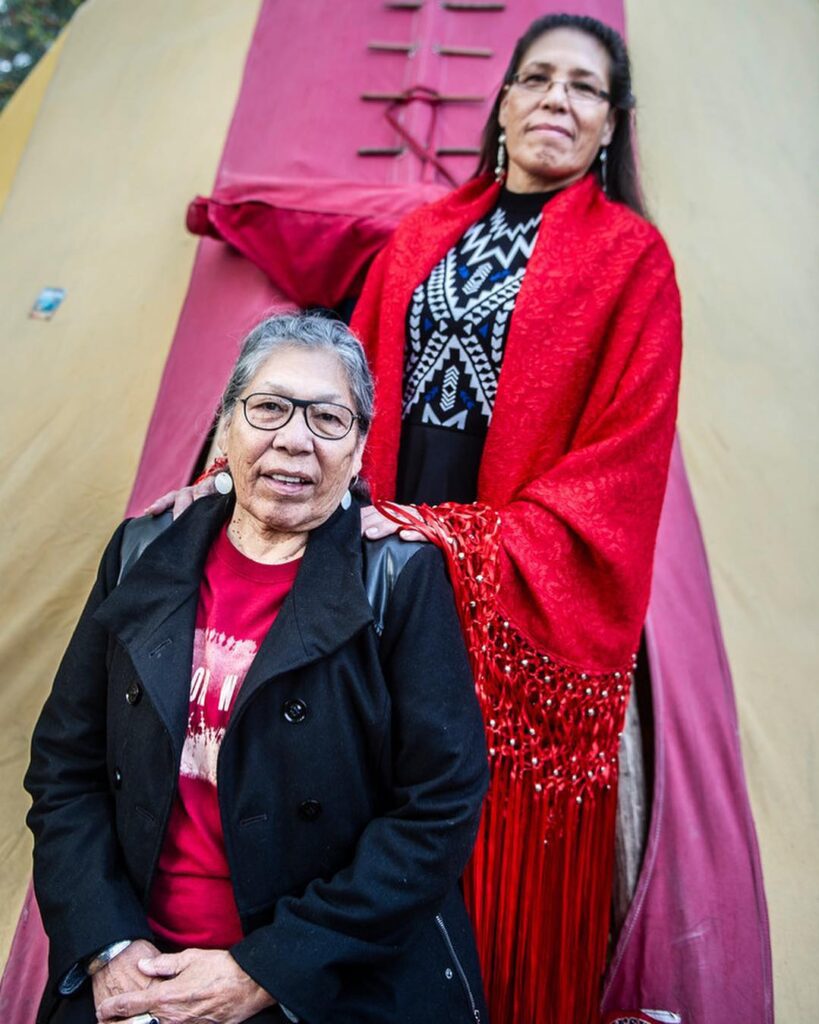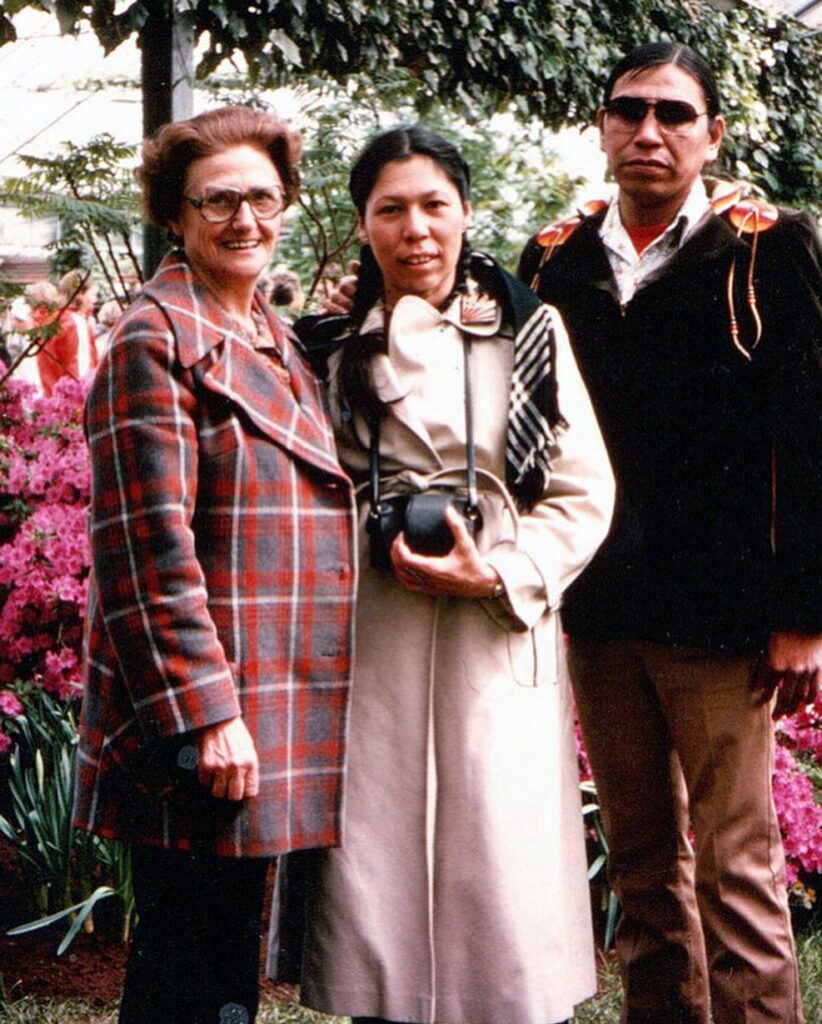CRST member honored at 50th Anniversary of Lakota Survival School
On February 26, 2024, the Warrior Women Project hosted a day-long reunion in Rapid City and an oral history gathering of the We Will Remember Survival School (WWRSS) to celebrate the 50th anniversary of the founding of the school. The celebration honored co-founder Madonna Thunder Hawk (Wicahpi Luta Win, Cheyenne River Lakota) with a uniquely designed Star Quilt which included a flag representing WWRSS and a Wounded Knee 1973 flag. She also received an abundant bouquet of fresh flowers and an honor song by Keith Janis.
Thunder Hawk has been repeatedly recognized for her role in the American Indian Movement (AIM) and for her tireless commitment to justice for all Native Americans. She said, “This (WWRSS anniversary celebration) was the best honor for me EVER, because it came from the Survival School participants.”
In 1974, Madonna Thunder Hawk co-founded the WWRSS in Rapid City as a space for cultural revitalization and as an alternative to mainstream education. The survival school students chose to name the school ‘We Will Remember” to honor those who stood against the US government at Wounded Knee 1973 and all Wounded Knee Veterans.
Designed to respond to the needs of Native American children and youth experiencing racism and intolerance within the local public school system, it was the first alternative education setting in South Dakota. WWRSS became part of a national network that included a federation of survival schools, mostly young people who participated fully in the revolution of cultural revitalization.
On March 9, 2024, the Native Sun News Today (NSNT) spoke with Thunder Hawk (MTH) and her daughter Marcella Gilbert (MG), who was a teen student at the WWRSS and helped to organize the anniversary celebration. Together they related a powerful history of the WWRSS and revealed themselves to be two excellent examples of “Women Who Advocate for Equity, Diversity, and Inclusion” – the theme of this year’s National Women’s History Month Celebration.
The following are direct quotes from the two strong, smart, brave Lakota women.
MTH: “After Wounded Knee ’73, (AIM) started working with the Wounded Knee Legal Defense/Offense Committee. Many AIM families were in Rapid City with their children for court and legal matters, sometimes for extended periods of time. The children were not welcome in the public schools. My ten-year-old son, Philip Gilbert, said, ‘We need our own school.’”
MG: “Everything with the school was impromptu and happened very organically. We started with studying the 1868 Treaty – everyone in the school had to know about it and what it meant for our time. It meant we (Native Americans) had a nation-to-nation relationship with the US government. It meant we had POWER! … The curriculum at the school was based on Native identity – who we were and what that meant…
“After Wounded Knee ’73, there was international awareness of AIM. The AIM house in Rapid City became a point of contact for national and international individuals and groups who were interested in and supportive of AIM. They sent us donations and letters of support. Those of us students who knew how to read and write would respond to the letters and give updates on our activities. It developed into a pen pal situation.
“We (organically) developed a student exchange program with other Native survival schools. Students from other schools would come to visit us and some of us would go to visit them. We learned about many other Native cultures on Turtle Island (North America) …A young man from Germany came and stayed a while during the summer for several years…”
NSNT NOTE: The WWRSS eventually moved to the Pine Ridge Reservation to land owned by MTH’s in-laws. The curriculum continued to evolve organically in response to the students’ interests and needs. All curricula related to the current issues of that time.
MTH: “Everything we did related to the AIM. It was all about taking care of one another, protecting, and revitalizing the culture. We brought ceremonies back into the open after the ceremonies had been illegal for decades. We reclaimed our religious freedom. Everywhere we went, we always went with a prayer.
“In 1978, Dennis Banks organized the first ‘Longest Walk’ from Alcatraz Island to the White House to bring attention to the issues of Native Americans. Students from the WWRSS participated in the walk for 3 – 4 months. They joined the walk in Indiana and were there when the walk arrived in Washington, D.C.… It was their decision to do the walk. We treated our young people as being capable (of making decisions). They understood the issues and how important (the walk) was. …You gotta respect young people. They will surprise you…
“There was still a lot of responsibility at home so I stayed to do the things needed at home. Young adults in their late teens and early twenties were the ‘moccasins on the ground’ (on the walk). Older students and volunteers looked after the younger students.”
MG: “It was AMAZING. As a teenager, it was so much to take in! People from all over the world participated. There were Asian Buddhists who came to walk and we met tribal people from many Native Nations who welcomed and allowed us to walk through their land. …We learned so much about different tribal protocols. …
“After the walk, we went directly from Washington, D.C. to Havanna, Cuba for the 11th World Festival of Youth and Students….”
NSNT Note: The 11th World Festival of Youth and Students was held from July 28 – August 5, 1978. Attended by 18,500 young people from 145 countries, this was the first time the festival was held in the western hemisphere. For the opening ceremony, thousands of young people from around the world marched three kilometers through the main avenues of the capital towards the Latin American Stadium where the ceremony was held. It ended with a huge demonstration in the historic Plaza de la Revolución José Martí.
NSNT: “Who funded your travel to Washington, D.C. and to Cuba?”
MTH: “We didn’t have to do fundraising. When our students walked to Washington, D.C. with Dennis Banks, local religious groups along the way would offer lodging and meals. Cities would allow us to camp in their parks. They came to us. … It was (a sign of) the times. The rest of the country was on the move (along with us). We were working with the anti-war movement, the no nukes movement, the environmental movement. AIM leaders were meeting with leaders all over the world. We had contacts nationally and internationally. We were working with the Black Hills Alliance and the Women of All Red Nations. People came to us with support and donations. …
“One reason our survival school was successful was that most of the students were bilingual (as children they learned their Lakota language along with English). They understood both worlds (the Native world and the Euro-American world.)
MG: “I attended WWRSS from eighth grade until the school disbanded in 1981. Then I went to Job Corps and completed my GED. From my survival school experience, I had the confidence to know that I was smart enough to do it. After earning my GED, I earned my B.S. in Community Health Education and master’s degree in nutrition from SD State University. My brother Philip Gilbert got his GED and then became a carpenter with a certification as an electrician. Many survival school students went on to earn their GED and go on to higher education …
“My survival school experience also trained me to be a life-long activist. You have no choice. Once you learn this stuff, you can’t unlearn it.”
NSNT: Why did WWRSS disband?
MTH: “Two reasons: First, there was an epidemic of spontaneous abortions on the Pine Ridge Reservation (where the school was located). Many women were losing their babies between two and four months of pregnancy. The doctors carelessly said, “It could be anything (causing the epidemic).”
One doctor dismissed the crisis with, “It could be a lack of personal hygiene (among the native mothers),” revealing his ignorance and racism. This extremely offensive statement motivated Women of All Red Nations (WARN) to find the truth.’
“With help from the Black Hills Alliance, WARN arranged for water testing in the area and learned that the water was contaminated with nuclear waste and unsafe. That’s one reason the school disbanded.
“Second, the WWRSS students were ‘aging out’ and the SD public schools began to offer alternative education.
MG: “We (WWRSS students) returned to our families and lived our lives knowing we could do and be more. Many former students came to the 50th anniversary celebration and showed great respect and admiration for Madonna. She had an impact. She changed young people’s lives. One said, ‘She taught me WHO I AM and taught me to be proud of who I am.’”
Dr. Elizabeth Castle, the director of the Warrior Women Project, said, “The survival school movement is an obvious powerful response to a boarding school initiative, to surviving an unrecognized genocide.”
According to the website (www.warriorwomen.org/), “The Warrior Women Project is dedicated to preserving, amplifying, and sharing the untold stories and ongoing legacy of Indigenous Women’s activism… Our mission is to empower these warrior women’s stories, ensuring their contributions to social justice are both accessible and inspirational for years to come.”
The Project is actively seeking former students of the WWRSS school to contribute to an oral history project about the school. These stories of resistance and empowerment are being recorded to ensure they are preserved for generations to come. Once archived, the stories will inform curricula and teaching tools, ensuring that the legacy of Indian-led decolonizing education can be passed on to future generations.
Community financial support is needed to preserve this little-known chapter in the history of decolonizing education. To contribute to the oral history project and/or donate financial support, contact the project through their website.
(Contact Grace Terry at angelsabide.com)
The post CRST member honored at 50th Anniversary of Lakota Survival School first appeared on Native Sun News Today.


